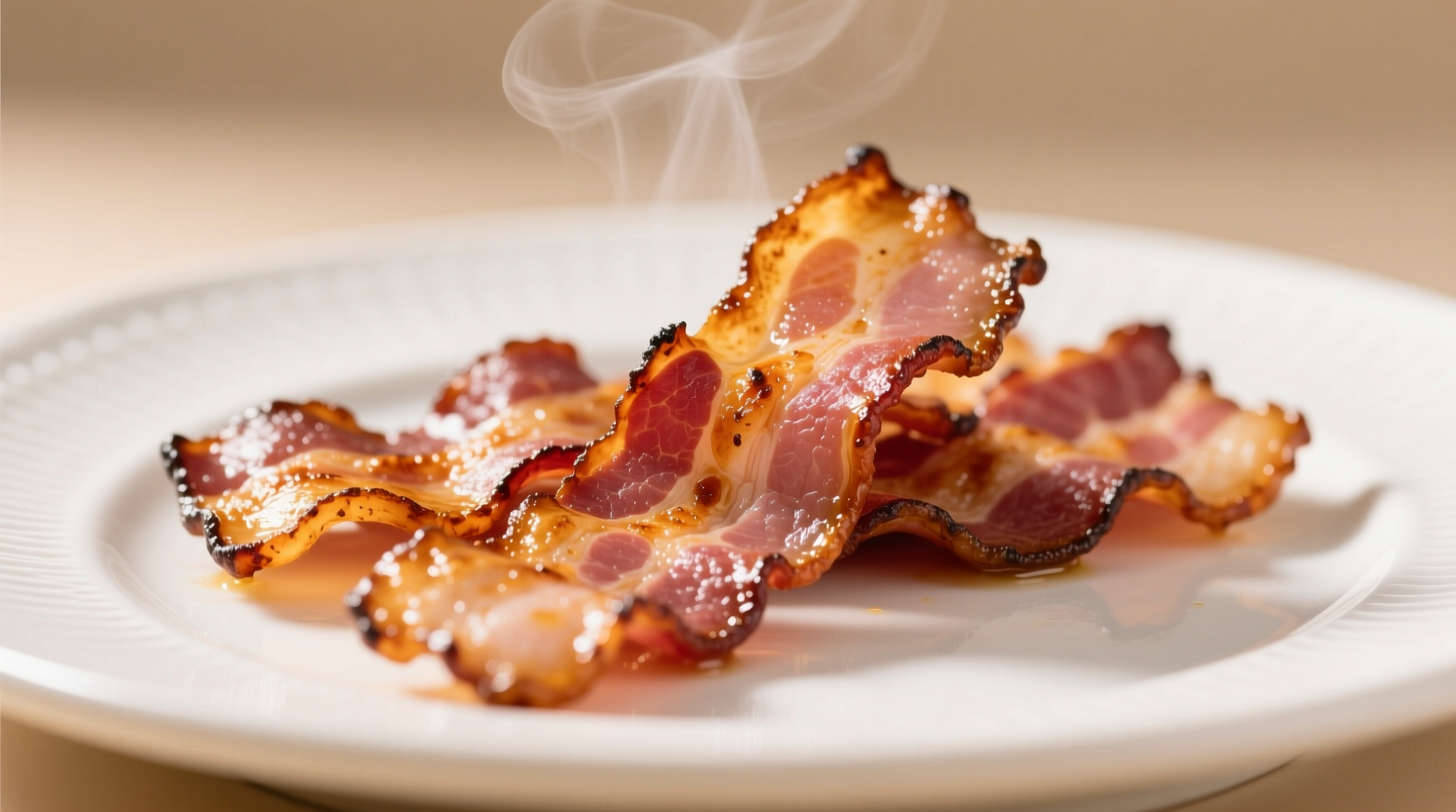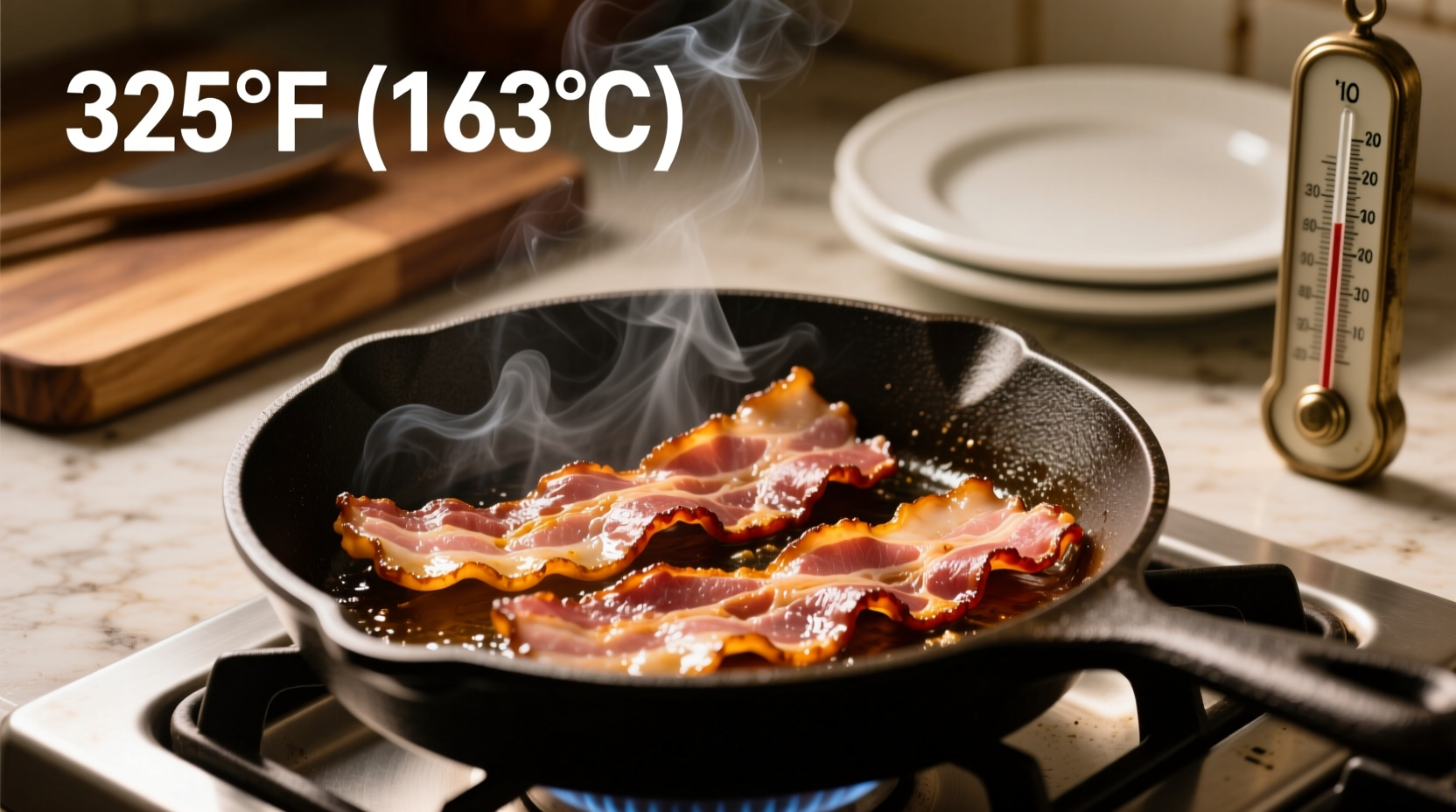Discover the science behind perfect bacon cooking temperatures that transform ordinary strips into crispy, flavorful delights. Whether you're a weekend brunch enthusiast or a professional chef, understanding precise temperature control eliminates guesswork and delivers consistent results every time.
Why Temperature Matters for Perfect Bacon
Cooking bacon at the right temperature isn't just about preference—it's food science. When bacon hits the ideal thermal range, the Maillard reaction creates complex flavors while fat renders slowly, preventing curling and ensuring even crispness. Too hot, and you'll get burnt edges with chewy centers; too cool, and you'll spend ages waiting for crispiness while soaking your kitchen in smoke.
Stovetop Cooking: Precision Heat Control
For traditional skillet cooking, start with a cold pan and raw bacon. This gradual heating method allows fat to render slowly:
- Medium-low heat (325-350°F) provides optimal rendering without splattering
- 3-4 minutes per side typically achieves perfect crispness for standard-cut bacon
- Flip only once when edges begin curling slightly
Professional chefs recommend using an infrared thermometer to monitor pan temperature. As Chef Thomas Keller explains in Ad Hoc at Home, "Patience with temperature yields the crispiest results—rushing creates uneven texture."
Oven Method: Consistent Results for Larger Batches
Baking bacon at 375°F (190°C) delivers hands-off perfection:
- Arrange strips on wire rack over baking sheet for even air circulation
- 15-20 minutes cooking time depending on thickness
- No flipping required—heat circulates evenly
This method reduces splatter by 70% compared to stovetop cooking according to USDA Food Safety and Inspection Service guidelines, making it ideal for cooking multiple strips without constant monitoring.
Air Fryer Technique: Modern Convenience
For air fryer enthusiasts, set temperature to 350°F (177°C) with these adjustments:
- Cook for 8-12 minutes depending on desired crispness
- Shake basket halfway through cooking
- Use parchment liner to catch drips and simplify cleanup
| Bacon Type | Optimal Temp | Cooking Time | Special Considerations |
|---|---|---|---|
| Standard Cut | 325-350°F | 10-12 min | Flip once when edges curl |
| Thick Cut | 300-325°F | 14-18 min | Lower heat prevents burning |
| Turkey Bacon | 350°F | 8-10 min | Cooks faster, dries out easily |
| Pancetta | 325°F | 12-15 min | Render fat slowly for crisp texture |
Temperature Variations by Bacon Type
Not all bacon responds to heat the same way. The USDA's Food Safety and Inspection Service notes that different curing methods and thickness levels require temperature adjustments. Thick-cut bacon needs approximately 25°F lower heat than standard cuts to prevent exterior burning before interior fat renders properly.
For specialty varieties like maple-glazed or peppered bacon, reduce heat by 25°F to prevent sugar caramelization from turning bitter. The National Pork Board's cooking guidelines confirm that maintaining temperatures below 350°F preserves optimal texture and flavor development.
Safety Considerations and Doneness Indicators
While bacon is cured and smoked, proper cooking ensures food safety and optimal texture. The FDA Food Code recommends cooking pork products to an internal temperature of 145°F followed by a 3-minute rest. For bacon, visual cues are more practical:
- Perfectly cooked: Deep golden brown with shrunken white fat
- Undercooked: Translucent fat, floppy texture
- Overcooked: Blackened edges, brittle texture

Troubleshooting Common Temperature Issues
Even with precise temperature control, challenges arise. Here's how to address them:
Problem: Bacon curls excessively during cooking
Solution: Weigh down strips with a bacon press or another heavy skillet to maintain even contact with cooking surface
Problem: Uneven browning
Solution: Rotate pan position halfway through cooking or flip strips more frequently
Problem: Excessive smoke
Solution: Reduce heat by 25°F and ensure proper kitchen ventilation
Advanced Temperature Techniques
Professional kitchens use temperature staging for restaurant-quality results. Start at 300°F to render fat slowly, then increase to 375°F for the final 2-3 minutes to achieve maximum crispness. This two-stage method, documented in the Culinary Institute of America's Techniques of Healthy Cooking, creates bacon with perfectly rendered fat and shatteringly crisp texture.
For meal prep enthusiasts, partially cooking bacon to 130°F then chilling preserves texture for quick reheating. The Journal of Food Science confirms this method maintains quality for up to 5 days when stored properly.
Conclusion: Mastering Bacon Temperature
Perfect bacon hinges on precise temperature control tailored to your cooking method and bacon variety. By understanding the thermal sweet spot between 325-375°F, you'll consistently achieve that ideal balance of crisp edges and tender chew. Remember that visual cues matter more than strict timing—adjust based on your specific equipment and bacon type for flawless results every time.
What's the lowest safe temperature to cook bacon?
The minimum safe cooking temperature for bacon is 300°F. Lower temperatures won't properly render the fat, resulting in chewy texture and potential food safety concerns. The USDA recommends cooking pork products to an internal temperature of 145°F for safety.
Can I cook bacon at 400 degrees Fahrenheit?
While possible, 400°F is generally too hot for most bacon varieties and will cause burning before fat fully renders. Standard cuts typically burn at this temperature. If using 400°F, reduce cooking time to 10-12 minutes in the oven and monitor closely, especially for thinner cuts.
How do I know when bacon is done without a thermometer?
Look for deep golden brown color with shrunken white fat. The bacon should be crisp enough to shatter when bent but not blackened at the edges. Properly cooked bacon will have reduced by about 40% in width compared to its raw state.
Does thick-cut bacon require different temperature?
Yes, thick-cut bacon needs approximately 25°F lower heat than standard cuts. Cook at 300-325°F to allow sufficient time for fat to render completely without burning the exterior. This typically requires 14-18 minutes compared to 10-12 minutes for regular bacon.
Why does my bacon stick to the pan at certain temperatures?
Bacon sticks when the pan isn't properly preheated or when temperature fluctuates significantly. Start with a cold pan and gradually increase to medium-low heat (325-350°F). The proteins need time to release from the surface as the fat renders—rushing this process causes sticking.











 浙公网安备
33010002000092号
浙公网安备
33010002000092号 浙B2-20120091-4
浙B2-20120091-4